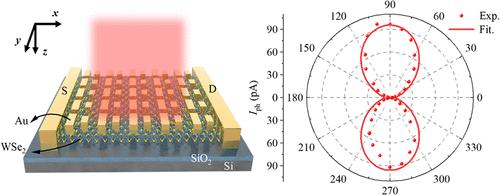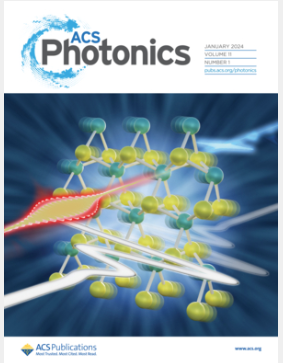Highly Polarized Near-Infrared Photodetection in Monolayer WSe2 Enabled by Plasmonic Bound States in the Continuum
IF 6.7
1区 物理与天体物理
Q1 MATERIALS SCIENCE, MULTIDISCIPLINARY
引用次数: 0
Abstract
Polarization-sensitive near-infrared (NIR) photodetection plays a crucial role in applications such as object recognition, environmental monitoring, and navigation. While nanostructured or anisotropic two-dimensional (2D) materials offer a promising alternative for miniaturization, their polarization sensitivity often remains insufficient for practical implementation. To overcome these limitations, we present a highly polarization-sensitive NIR photodetector based on monolayer WSe2 operating below its intrinsic bandgap, enabled by anisotropic absorption and hot-carrier injection through plasmonic quasi-bound states in the continuum (quasi-BICs). By integrating asymmetrically paired gold nanorods in a long–short configuration on monolayer WSe2, a plasmonic quasi-BIC mode is excited, resulting in a polarization absorption ratio of 276 at the telecommunication wavelength of approximately 1.5 μm. The photodetector exhibits a high degree of linear polarization (DOLP) of 0.95 and a narrow full width at half-maximum (FWHM) of 70 nm, among the best performances for 2D-material-based photodetectors. Furthermore, we demonstrate its application in polarization-encoded telecommunication and polarization-resolved NIR imaging, highlighting its potential for practical applications. This work underscores the potential of integrating plasmonic quasi-BICs with 2D materials to realize compact, multifunctional NIR photodetectors with sub-bandgap operation, featuring simultaneously enhanced polarization sensitivity and spectral selectivity.

连续体中等离子束缚态实现的单层WSe2高偏振近红外光探测
偏振敏感的近红外(NIR)光探测在物体识别、环境监测和导航等应用中起着至关重要的作用。虽然纳米结构或各向异性二维(2D)材料为小型化提供了一个有希望的替代方案,但它们的极化灵敏度通常不足以实现实际应用。为了克服这些限制,我们提出了一种基于单层WSe2的高偏振灵敏度近红外光电探测器,该探测器工作在其固有带隙以下,通过各向异性吸收和通过连续体中的等离子体准束缚态(准bic)注入热载子来实现。通过在单层WSe2上以长-短结构对非对称配对金纳米棒进行积分,激发出等离子体准bic模式,在约1.5 μm的通信波长处极化吸收比为276。该光电探测器具有较高的线偏振度(DOLP)为0.95,半峰全宽(FWHM)为70 nm,是目前二维材料光电探测器中性能最好的器件之一。此外,我们展示了它在偏振编码电信和偏振分辨近红外成像中的应用,突出了它的实际应用潜力。这项工作强调了将等离子体准bic与二维材料集成在一起的潜力,以实现具有亚带隙操作的紧凑、多功能近红外光电探测器,同时具有增强的偏振灵敏度和光谱选择性。
本文章由计算机程序翻译,如有差异,请以英文原文为准。
求助全文
约1分钟内获得全文
求助全文
来源期刊

ACS Photonics
NANOSCIENCE & NANOTECHNOLOGY-MATERIALS SCIENCE, MULTIDISCIPLINARY
CiteScore
11.90
自引率
5.70%
发文量
438
审稿时长
2.3 months
期刊介绍:
Published as soon as accepted and summarized in monthly issues, ACS Photonics will publish Research Articles, Letters, Perspectives, and Reviews, to encompass the full scope of published research in this field.
 求助内容:
求助内容: 应助结果提醒方式:
应助结果提醒方式:


